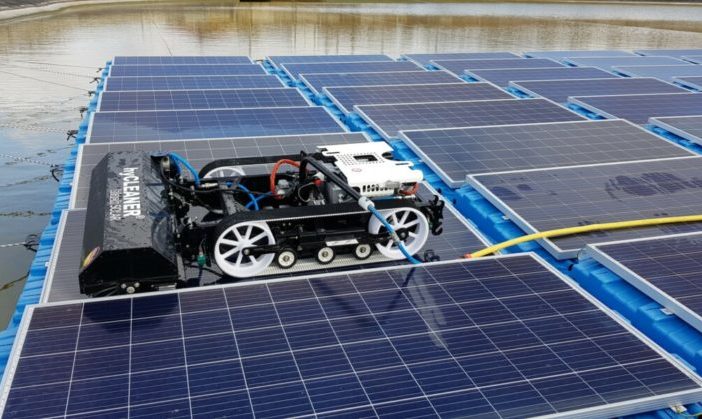- Isigenere, a Spanish engineering company and provider of floating PV structures, has tested a new cleaning robot on a 500 kW floating installation built on an irrigation pond in Mérida province, southern Spain.
- The hyCleaner black Solar facelift robot, produced by German manufacturer TG hylift, has a modular design and uses only water without any detergent or chemical additives to clean the panels.
At the Spanish floating plant, the robot utilizes water from an existing irrigation tank located at the facility. However, its manufacturers state that it can also make use of rainwater, tap water, and recycled water, as well as all kinds of water preparation systems.
As the dirt on the panels is only natural dirt, the cleaning water can fall back into the pond without problems.
Water supply is connected through a quick connect fitting, and power is provided by built-in lithium-ion batteries. The robot is simply placed manually on the first row of modules and can be driven by an operator, via remote control with more than 100 meters range. Its design ensures minimal disturbance of the floats as it moves across the installation, and large track wheels make it easy to move between individual modules.
The robot also has an edge detection system, stopping it automatically when it reaches the plant edges – even if the operator keeps pressing the joystick to move forward. Once removed from this ‘danger zone’, all movements are released again, and cleaning continues.
Depending on the type and intensity of the dirt, the robot can be driven at different speeds. The rotating wash brush has a width of 1100 mm and adapts perfectly to the width of the module. The surfaces of the modules and frames are cleaned in a single operation.
TG hyLIFT states that its robots are manufactured in Germany “from development to production and assembly to quality assurance and careful customer service.” It added that the robot can be used in all installations, also in inclined ones.
Author: Pilar Sánchez Molina
This article was originally published in pv magazine and is republished with permission.
















